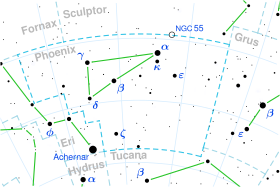Star in the constellation Phoenix
Eta Phoenicis (η Phe) is a class A0IV[ 2] star in the constellation Phoenix . Its apparent magnitude is 4.36[ 2] [ 1]
Eta Phoenicis has two reported companions; in addition to a distant secondary, B, at magnitude 11.5 and separation 20", the primary has a reported companion Ab with an estimated separation of 6.8 AU , a period slightly longer than 10 years, a magnitude of 8.5, and a spectral type around G5V.[ 8] [ 9] debris disk .[ 10]
References
^ a b c d e f Van Leeuwen, F. (2007). "Validation of the new Hipparcos reduction". Astronomy and Astrophysics . 474 (2): 653– 664. arXiv :0708.1752 Bibcode :2007A&A...474..653V . doi :10.1051/0004-6361:20078357 . S2CID 18759600 . Vizier catalog entry ^ a b c d e Anderson, E.; Francis, Ch. (2012). "XHIP: An extended hipparcos compilation". Astronomy Letters . 38 (5): 331. arXiv :1108.4971 Bibcode :2012AstL...38..331A . doi :10.1134/S1063773712050015 . S2CID 119257644 . Vizier catalog entry ^ a b Mallama, A. (2014). "Sloan Magnitudes for the Brightest Stars". The Journal of the American Association of Variable Star Observers . 42 (2): 443. Bibcode :2014JAVSO..42..443M . Vizier catalog entry ^ Gontcharov, G. A. (2006). "Pulkovo Compilation of Radial Velocities for 35 495 Hipparcos stars in a common system". Astronomy Letters . 32 (11): 759– 771. arXiv :1606.08053 Bibcode :2006AstL...32..759G . doi :10.1134/S1063773706110065 . S2CID 119231169 . ^ a b c Zorec, J.; Royer, F. (2012). "Rotational velocities of A-type stars". Astronomy & Astrophysics . 537 : A120. arXiv :1201.2052 Bibcode :2012A&A...537A.120Z . doi :10.1051/0004-6361/201117691 . S2CID 55586789 . Vizier catalog entry ^ a b David, Trevor J.; Hillenbrand, Lynne A. (2015). "The Ages of Early-Type Stars: Strömgren Photometric Methods Calibrated, Validated, Tested, and Applied to Hosts and Prospective Hosts of Directly Imaged Exoplanets". The Astrophysical Journal . 804 (2): 146. arXiv :1501.03154 Bibcode :2015ApJ...804..146D . doi :10.1088/0004-637X/804/2/146 . S2CID 33401607 . Vizier catalog entry ^ Gontcharov, G. A. (2012). "Dependence of kinematics on the age of stars in the solar neighborhood". Astronomy Letters . 38 (12): 771– 782. arXiv :1606.08814 Bibcode :2012AstL...38..771G . doi :10.1134/S1063773712120031 . S2CID 118345778 . Vizier catalog entry ^ Mason, Brian D.; Wycoff, Gary L.; Hartkopf, William I.; Douglass, Geoffrey G.; Worley, Charles E. (2001). "The 2001 US Naval Observatory Double Star CD-ROM. I. The Washington Double Star Catalog" . The Astronomical Journal . 122 (6): 3466. Bibcode :2001AJ....122.3466M . doi :10.1086/323920 Vizier catalog entry ^ Marion, L.; Absil, O.; Ertel, S.; Le Bouquin, J.-B.; Augereau, J.-C.; Blind, N.; Defrère, D.; Lebreton, J.; Milli, J. (2014). "Searching for faint companions with VLTI/PIONIER". Astronomy & Astrophysics . 570 : A127. arXiv :1409.6105 Bibcode :2014A&A...570A.127M . doi :10.1051/0004-6361/201424780 . S2CID 8756486 . ^ Marion, L.; et al. (October 2014), "Searching for faint companions with VLTI/PIONIER. II. 92 main sequence stars from the Exozodi survey", Astronomy & Astrophysics , 570 : 12, arXiv :1409.6105 Bibcode :2014A&A...570A.127M , doi :10.1051/0004-6361/201424780 , S2CID 8756486 , A127.
